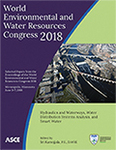World Environmental and Water Resources Congress 2018
Time-Based Estimation of Reservoir Sedimentation Impacts
Publication: World Environmental and Water Resources Congress 2018: Hydraulics and Waterways, Water Distribution Systems Analysis, and Smart Water
ABSTRACT
Existing empirical methods to predict reservoir sediment distribution are largely based on the original reservoir shape. To describe reservoir sediment distribution, one usually compares the original reservoir capacity and surface area as functions of the water depth to a future reservoir capacity and surface area. Examination of survey data of 23 reservoirs of Bureau of Reclamation found that area reduction method (ARM) produces the best results with existing Bureau of Reclamation data. Further examinations show that the reservoir type determined only from the reservoir shape usually does not always produce the best sediment distribution fitting compared to reservoir survey data. Reservoir sedimentation pattern depends not only on the reservoir shape, but also on reservoir operation rules, water surface levels, and sediment size distribution. Several reservoir operation parameters are presented in an attempt to relate sediment distribution with reservoir operations. Initial results show that sediment distribution is more complex than what simple parameters can present. Reservoir shape, defined as slope of the depth-capacity curve on log-log coordinates, presents the best correlation with the sediment distribution. Poor correlations between proposed reservoir operation parameters and sediment distribution were found. Sediment size distribution would likely improve the results, but this data is not available for the majority of the reservoirs analyzed in this study.
Get full access to this chapter
View all available purchase options and get full access to this chapter.
REFERENCES
Borland, W. M., and Miller, C. R. (1958). "Distribution of sediment in large reservoirs." J. Hydraul. Div. ASCE HY2.
Cristofano, E. A. (1953). Area increment method for distributing sediment. U.S. Bureau of Reclamation, Albuquerque, N. M.
Mohammadzadeh-Habili, J., Heidarpour, M., Mousavi, S. F., and Haghiabi, A. H. (2009). "Derivation of reservoir’s area-capacity equations." Journal of Hydrologic Engineering, Vol. 14(9), 1017–1023.
Moody, W. T. (1962). Determination of the maximum elevation of complete sedimentation in a reservoir: Memorandum. U. S. Bureau of Reclamation (unpublished).
Rahmanian, M. R., and Banihashemi, M. A. (2012). "Introduction of a new empirical reservoir shape function to define sediment distribution pattern in dam reservoirs." Iranian Journal of Science and Technology. Transactions of Civil Engineering, Vol. 36(C1), 79–92.
Reclamation. (1962). Revision of the Procedure to Compute Sediment Distribution in Large Reservoirs. Sedimentation Section, Bureau of Reclamation, Denver, CO.
Information & Authors
Information
Published In
World Environmental and Water Resources Congress 2018: Hydraulics and Waterways, Water Distribution Systems Analysis, and Smart Water
Pages: 82 - 93
Editor: Sri Kamojjala, Las Vegas Valley Water District
ISBN (Online): 978-0-7844-8142-4
Copyright
© 2018 American Society of Civil Engineers.
History
Published online: May 31, 2018
Authors
Metrics & Citations
Metrics
Citations
Download citation
If you have the appropriate software installed, you can download article citation data to the citation manager of your choice. Simply select your manager software from the list below and click Download.
